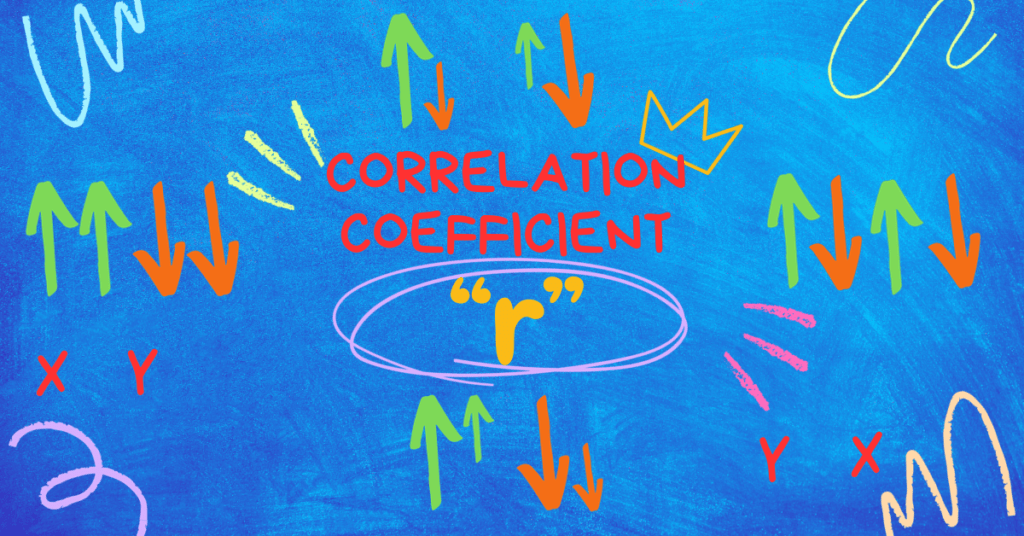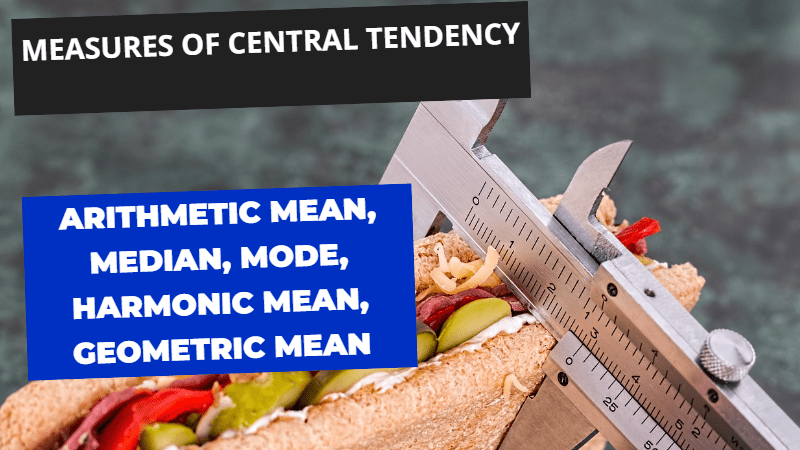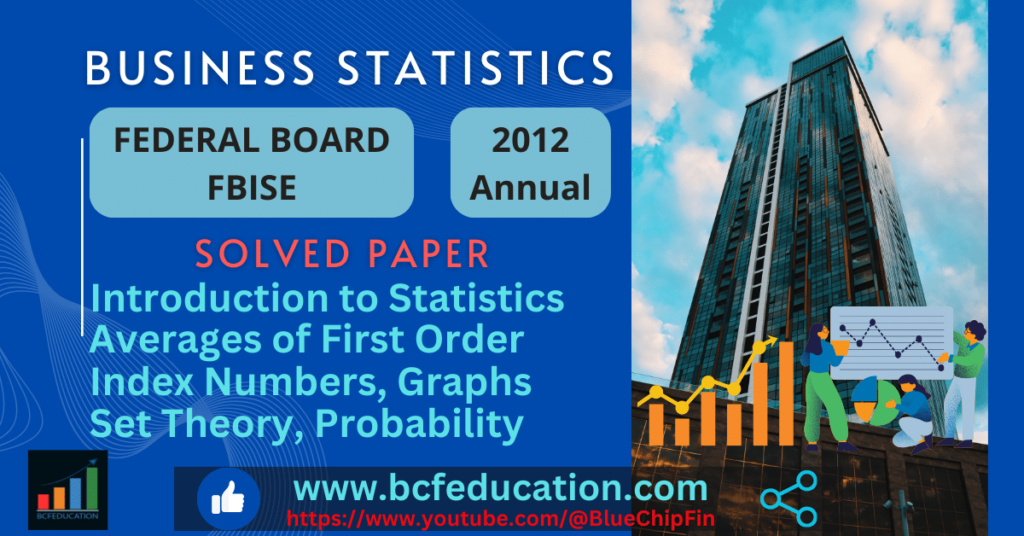In this article, titled “Statistics II Solved Paper 2012 FBISE,” we will walk through a comprehensive analysis of the solved paper, addressing various aspects of statistics as encountered in the 2013 FBISE exam. The post will cover multiple-choice questions (MCQs), short-answer questions, numerical problems, and extensive questions on fundamental topics such as probability distribution, binomial and hypergeometric distributions, normal distribution, sampling distribution, inferential statistics (hypothesis testing and estimation), and association using the Chi-square test.
Each topic will be explained in detail, with solutions to guide students through the process of answering such questions efficiently. Whether you’re preparing for an exam or just brushing up on your statistics knowledge, this post serves as a helpful resource for mastering key statistical concepts and methodologies. This topic is equally important for the students of statistics across all the major Boards and Universities such as FBISE, BISERWP, BISELHR, MU, DU, PU, NCERT, CBSE & others & across all the statistics, business & finance disciplines.
Statistics II Solved Paper 2012 FBISE
MCQS
| Fill the relevant bubble against each question according to curriculum: | |||
| 1 | In how many ways a team of four players can be chosen from 1 o players? | ||
| A) | 40 | B) | 210 |
| C) | 5040 | D) | None of these |
| 2 | The events A and 8 are mutually exclusive then | ||
| A) | A U B = S | B) | A ∩ B = A |
| C) | A ∩ B = ϕ | D) | None of these |
| 3 | If the random variable “X” denotes the number of heads when three distinct coins are tossed, then “X” assumes the value | ||
| A) | 1,2,3 | B) | 1,3,3, 1 |
| C) | 0, 1,2,3 | D) | None of these |
| 4 | If E(X) = 1.5, Var(X) = 0.5 then E(X²) will be: | ||
| A) | 2.75 | B) | 2.25 |
| C) | 0.25 | D) | 2.7 |
| 5 | In a multiple choice test there are five possible answers to each of 20 questions If a candidate guesses the correct answer each time, what is the mean number of the correct answer? | ||
| A) | 5 | B) | 1/5 |
| C) | 4 | D) | 20 |
| 6 | Given N = 11 n= 5 K = 6, then P ( x ≥ 1) equals: | ||
| A) | 1 | B) | 1/66 |
| C) | 65/66 | D) | 461/462 |
| 7 | Standard deviation of standard normal distribution is: | ||
| A) | 1 | B) | 0 |
| C) | 1.2 | D) | None of these |
| 8 | In normal probability distribution P(z < -1) = 0.1587 then P (z>1) is: | ||
| A) | 0.6587 | B) | 0.1587 |
| C) | 0.8413 | D) | 0.3413 |
| 9 | The measure on sample is called: | ||
| A) | Statistics | B) | Population |
| C) | Statistic | D) | Parameter |
| 10 | The standard deviation of sampling distribution is called: | ||
| A) | Sampling error | B) | Non-sampling error |
| C) | Standard error | D) | Bias |
| 11 | A population contains two Items and four items are selected at random with replacement, then all possible samples shall be | ||
| A) | 16 | B) | 8 |
| C) | [ begin{pmatrix}4 \C \2 \end{pmatrix} ] | D) | 4 |
| 12 | A statistic ɵ̂ is an estimator of parameter ɵ, then it will be unbiased if: | ||
| A) | E(ɵ̂)>ɵ | B) | E(ɵ̂)=ɵ |
| C) | E(ɵ̂)<ɵ | D) | E(ɵ̂)≠ɵ |
| 13 | For large sample size (n>30) the value of Z α/2 for 90% confidence interval shall be: | ||
| A) | ±1.96 | B) | ±1.645 |
| C) | ±2.33 | D) | ±2.58 |
| 14 | In testing hypothesis about difference between population means for small samples and unknown standard deviations, the degree of freedom shall be: | ||
| A) | n-1 | B) | n1+n2-2 |
| C) | n-2 | D) | 2n-2 |
| 15 | Ho is true and we reject it is called: | ||
| A) | Type II error | B) | Standard Error |
| C) | Type I error | D) | Sampling Error |
| 16 | For α= 0.0 I the critical value for Z = ——- for one tailed test are equal to: | ||
| A) | – 1.96 or 1.96 | B) | – 2.33 or 2.33 |
| C) | – 1.645 or 1.645 | D) | None of these |
| 17 | A binary digit is commonly called: | ||
| A) | Bit | B) | Byte |
| C) | Kilobyte | D) | Gigabyte |
Short Questions
(i) Distinguish between Permutation & Combination.
Answer:
Permutation
In permutation, order of the elements matters. For example, if there is a specific number 256, which means strictly 256, neither 526 nor 652. Permutation is used when order of the items is important. In mathematics permutation can be calculated through following formula:
[ begin{pmatrix}mathbf{n} \mathbf{P} \mathbf{r} \end{pmatrix}mathbf{=}frac{mathbf{n!}}{left( mathbf{n – r}right)mathbf{!}} ]
Combination
In combination, order of the elements does not matter. For example, if there is one basket containing apples, bananas and oranges, no matter what comes first either banana, apples, oranges or oranges, bananas and apples etc. Combination is used when order of the elements is not important. Formula for combination is:
[ begin{pmatrix}mathbf{n} \mathbf{C} \mathbf{r} \end{pmatrix}mathbf{=}frac{mathbf{n!}}{mathbf{r!}left( mathbf{n- r} right)mathbf{!}} ]
(ii) What is the sample space when three distinct coins are tossed? Also specify the event A for exactly two heads.
Solution
Sample Space η(S) = 2³= 8
All possible samples =
| HHH | HHT | HTH | THH |
| TTT | TTH | THT | HTT |
Event: Exactly 2 Heads η(A) = 3
[ mathbf{P}left( mathbf{A} right)mathbf{= }frac{mathbf{eta(A)}}{mathbf{eta(S)}} ]
[ mathbf{P}left( mathbf{A} right)mathbf{= }frac{mathbf{3}}{mathbf{8}} ]
[ mathbf{P}left( mathbf{A} right)) textbf{= 0.375} ]
(iii) What is Probability density function? What are its properties?
Answer:
Probability density function (PDF) is a function that describes the likelihood of continuous random variable on a particular value. PDF determines probabilities in interval rather than a single point.
Properties of Probability Density Function
- Non Negative
The probability of an outcome cannot be negative.
[ mathbf{f}left( mathbf{x} right)mathbf{ geq 0 for all x values} ]
- Total Probability equals to one
Total area of PDF is equals to one in which we assume that random variable will take some value.
[ int_{mathbf{- infty}}^{mathbf{infty}}{mathbf{f}left( mathbf{x} right)mathbf{dx = 1 }} ]
- Probability of single value is zero
In PDF, the probability of a single value is zero.
[ mathbf{P(X = x) = 0} ]
- PDF defines the probabilities in interval
As we discussed above that total area of PDF is equals to one and probabilities are calculated in intervals.
[ mathbf{P}left( mathbf{a leq X leq b} right)mathbf{=}int_{mathbf{a}}^{mathbf{b}}{mathbf{f}left( mathbf{x} right)mathbf{dx}}) ]
(iv) Write a set A containing all vowels in the word “PUBLICATION”. Then find probability of A. Also find the probability of consonants.
Solution:
Set of Vowels (U, I, A, I, O) Set of Consonants (P, B, L, C, T, N)
Sample Space η(S) =
Event: Vowels η(A) = 5
Event: Consonants η(B) = 6
[ mathbf{P}left( mathbf{A} right)mathbf{= }frac{mathbf{eta(A)}}{mathbf{eta(S)}} ]
[ mathbf{P}left( mathbf{A} right)mathbf{= }frac{mathbf{5}}{mathbf{11}} ]
P(A)=0.455
[ mathbf{P}left( mathbf{B} right)mathbf{= }frac{mathbf{eta(B)}}{mathbf{eta(S)}} ]
[ mathbf{P}left( mathbf{B} right)mathbf{= }frac{mathbf{6}}{mathbf{11}} ]
P(B) = 0.5455
[ mathbf{P}left( mathbf{A} right)) textbf{= 0.5455} (mathbf{or P}left( mathbf{B} right)mathbf{= 1 – P}left( mathbf{A} right) ]
[ mathbf{ 1 – 0.4545 = 0.5455} ]
(v) Given a random variable “X” with E(X) = 2.5 and Variance(X) = 1.25 then find E(2x + 3), E(x²) & Var(2x – 5)
Solution
E(X) = 2.5, Variance(X) = 1.25
- E(2x + 3) = 2E(X) + 3 = 2 (2.5) + 3 = 5+3 = 8
- Variance (X) = E(X)² – [E(X)]²
1.25 = E(X)² – (2.5)²
E(X)² = 1.25 + 6.25
E(X)² = 1.25 + 6.25
E(X)² = 7.5
- Var(2x – 5) = E(2X – 5)² – [E(2X – 5)]²
Where E(2X – 5) = 2E(X) – 5 = 2(2.5) – 5 = 5 – 5 = 0 &
E(2X – 5)² = E(4X² – 20X + 25) = 4(7.5) – 20(2.5) + 25 = 30 – 50 + 25 = 5
Var(2x – 5) = 5 – (0)² = 5
(vi) What is Binomial distribution & what are its properties?
Answer: Binomial distribution is a function which is used to calculate the binomial experiment.
Function is given below:
[ mathbf{P(X = x) = }mathbf{b(x, n, p) }begin{pmatrix}mathbf{n} \mathbf{x} \end{pmatrix}mathbf{ }mathbf{p}^{mathbf{x}}mathbf{ }mathbf{q}^{mathbf{n – x}} ]
for x = 0, 1, 2, 3 …..n.
Where n = sample size, x = number of successes, n – x = number of failure
P =success and q = failure = 1 – p
Properties
- The mean of binomial distribution µ = np
- Variance 𝜎² = npq
- Standard Deviation σ= √npq
- ∑px = 1
- If p = q = ½ then probability distribution is symmetrical
- For negative skewness P>q
- For positive skewness P<q
(vii) If X is a binomial random variable with mean 2.4 & variance 0.96, find P(X = 0)
Solution
Mean = np = 2.4 & Var = npq = 0.96
npq = npq
2.4q = 0.96
q = 0.96/2.4 = 0.4
If q = 0.4 then p = 1 – q = 1 – 0.4 = 0.6
npq = npq
n(0.6)(0.4) = 0.96
n = 0.96/0.24 = 4
So now n = 4, p = 0.6, q = 0.4 and x = 0
[ mathbf{P(X = x) = b(x, n, p)}begin{pmatrix}mathbf{n} \mathbf{x} \end{pmatrix}mathbf{ }mathbf{p}^{mathbf{x}}mathbf{ }mathbf{q}^{mathbf{n – x}} ]
[ mathbf{P(X = 0) = b(0, 4, 0.6) }begin{pmatrix} mathbf{4} \ mathbf{0} \ end{pmatrix}mathbf{ }mathbf{(0.6)}^{mathbf{0}}mathbf{ }mathbf{(0.4)}^{mathbf{4 – 0}} ]
[ mathbf{P(X = 0) = 0.0256} ]
(viii) In normal distribution lower & upper quartiles are 15 & 25, respectively. Find mean & standard deviation of the distribution. Also find mean deviation.
Solution
As we know that:
Q1 = µ – 0.6745 𝜎
Q3 = µ + 0.6745 𝜎
15 = µ – 0.6745 𝜎
25 = µ + 0.6745 𝜎 sigma cancels each other
40 = 2µ
µ = 40/2 = 20
Now put the value of µ in any above equation to get 𝜎
15 = µ – 0.6745 𝜎
15 = 20 – 0.6745 𝜎
20 – 0.6745 𝜎 = 15
– 0.6745 𝜎 = 15 – 20
– 0.6745 𝜎 = – 5
𝜎 = 5/0.6745 = 7.4129
(ix) What is Standardized normal variate? Write down the equation of standardized normal distribution. Find the value of maximum ordinate.
Answer: The standardized Normal Variate or SNV which converts or transforms a normal random variable in to standard normal form. It is denoted by Z and it follows the standard normal distribution having mean zero (0) and standard deviation (1). Its formula is given below:
[Z = frac{X – mu}{sigma}]
Where:
Z = Standardized normal variate
X = Observed value
μ = Mean of the distribution
σ = Standard deviation of the distribution
Equation of the Normal Curve for SNV:
The equation for the standard normal curve (probability density function) is:
[mathbf{f}left( mathbf{Z} right)mathbf{= }frac{mathbf{1}}{sqrt{mathbf{2}mathbf{pi}}}mathbf{ }mathbf{e}^{mathbf{-}frac{mathbf{z}^{mathbf{2}}}{mathbf{2}}}]
Where:
Z = Standardized normal variate
e = Euler’s number (approximately 2.71828)
π = Mathematical constant (approximately 3.14159)
Maximum Ordinate
Peak value of the pdf of standard normal distribution is at Z = 0 is called maximum ordinate:
[ mathbf{f}left( mathbf{Z} right)mathbf{= }frac{mathbf{1}}{sqrt{mathbf{2}mathbf{pi}}}mathbf{ }mathbf{e}^{mathbf{-}frac{mathbf{z}^{mathbf{2}}}{mathbf{2}}} ]
[ mathbf{f}left( mathbf{0} right)mathbf{= }frac{mathbf{1}}{sqrt{mathbf{2(3.14159}}}mathbf{ }mathbf{2.71828}^{mathbf{-}frac{mathbf{0}^{mathbf{2}}}{mathbf{2}}} ]
[ mathbf{f}left( mathbf{0} right)mathbf{= 0.3989} ]
(x) Define a Random Sample. How would you obtain it?
Answer:
Random samples are sample points chosen randomly from population. Each sample point has equal chance to be selected. it must be ensured in random sampling that each sample should be chosen independently, has equal chance to be selected, each sample should not influence the other and each sample should represent the population.
Random Samples can be obtained through the following methods:
1. Simple Random Sampling
2. Systematic Random Sampling
3. Stratified Random Sampling
4. Cluster Random Sampling
5. Random Number Table or Software
(xi) If n = 5, N = 25 & 𝜎x̅ = 10 then find 𝜎²
Solution
If 𝜎x̅ = 10 then 𝜎²x̅ = 100
[ mathbf{sigma}^{mathbf{2}}overline{mathbf{x}}mathbf{=}frac{mathbf{sigma ²}}{mathbf{n}}mathbf{ }leftlbrack frac{mathbf{N – n}}{mathbf{N – 1}} rightrbrack ]
[ mathbf{100 =}frac{mathbf{sigma ²}}{mathbf{5}}mathbf{ }leftlbrack frac{mathbf{25 – 5}}{mathbf{25 – 1}} rightrbrack ]
[ mathbf{100 =}frac{mathbf{sigma ²}}{mathbf{5}}mathbf{ }leftlbrack mathbf{0.84} rightrbrack ]
[ leftlbrack frac{mathbf{100}}{mathbf{0.84}} rightrbrackmathbf{= }frac{mathbf{sigma ²}}{mathbf{5}} ]
[ mathbf{119 times 5 = }mathbf{sigma}mathbf{²} ] [ mathbf{sigma}mathbf{² = 595 Approx} ]
(xii) Differentiate between Point estimation & Interval estimation.
Answer:
POINT ESTIMATION
A point estimate of a population parameter is a single value of a statistic. For example,
the sample mean x̅ is a point estimate of the population mean μ. Similarly, the sample proportion p is a point estimate of the population proportion P.
INTERVAL ESTIMATION
An interval estimate is defined by two numbers, between which a population parameter is said to lie.For example, a < x < b is an interval estimate of the population mean μ. It indicates that the population mean is greater than a bit less than b.
(xiii) What is an Unbiased estimator?
Answer:
As we know that sample is a small representative part of population. Similarly, sample statistic is a representative of population parameter. So when sample statistic such as sample mean is equal to the population mean without any bias, it is called unbiased estimator otherwise it is called biased estimator.
(xiv) Given (AB) = 150 (αB) = 106 (Aβ) = 272 (αβ) = 1132 & N = 1660. Find the coefficient of association.
Solution
[ mathbf{Q =}frac{left( mathbf{AB} right)left( mathbf{alphabeta} right)mathbf{- (Abeta)(alpha B)}}{left( mathbf{AB} right)left( mathbf{alphabeta} right)mathbf{+ (Abeta)(alpha B)}} ]
[ mathbf{Q = }frac{left( mathbf{150} right)left( mathbf{1132} right)mathbf{- (272)(106)}}{left( mathbf{150} right)left( mathbf{1132} right)mathbf{+ (272)(106)}} ]
[ mathbf{Q = }frac{mathbf{169800 – 28832}}{mathbf{169800 + 28832}}mathbf{ } ]
[ mathbf{Q =}frac{mathbf{140968}}{mathbf{198632}}mathbf{= 0.709 Positive Association} ]
(xv) Determine whether the two attributes A & B are independent, positively associated or negatively associated (A) = 490 (α) = 570 (AB) = 294 (αB) = 380
Solution
| A | α | Total | |
| B | (AB) = (294) | (αB) = (380) | (B) = 674 |
| β | (A β) = (196) | (αβ) = (190) | (β) = 386 |
| Total | (A) = (490) | (α) = (570) | N or n = 1060 |
Here:
[AB = 294]
[frac{(A)(B)}{n} = frac{(490)(674)}{1060} = 311.56]
Conclusion
[ AB < frac{(A)(B)}{n} ]
[ 294 < 311.56 ]
Negative Association between A’ s and B’s
(xvi) Define one tailed & two tailed test.
Answer:
One-Tailed or One Sided Test
It is also called directional test. This type of test is used to test the significance and determine if there is a relationship between the variables in one direction.
Two-Tailed or Two Sided Test
It is also called non-directional test. This type of test is used to test the significance and determine if there is a relationship between the variables in either direction. In two tailed test α is divided by two and taking half on each side of the bell curve.
(xvii) Describe the procedure for testing hypothesis about mean of a normal population when population standard deviation is known.
Answer:
Sometimes the hypothesis about the population which is normal and its standard deviation 𝜎 is known. In this case Z test is used both for small and large sample size. Thus Z test is given below:
[ mathbf{Z =}frac{overline{mathbf{x}}mathbf{- mu}}{mathbf{sigma/}sqrt{mathbf{n}}} ]
where X̅ = Sample mean, µ = Population mean, 𝜎 = population standard deviation and n = sample size
(xviii) Given X̅1 = 26, X̅2 = 18, 𝜎x̅1 – x̅2 = 3.41, Ho: µ1≤µ2 & α = 0.05. Find “Z” and make statistical decision.
Solution
Step 1 Hypothesis
Ho: µ1≤µ2
H1: µ1>µ2
Step 2 Level of Significance
α = 0.05
Step 3 Test Statistic
[ mathbf{Z =}frac{left( {overline{mathbf{x}}}_{mathbf{1}}mathbf{-}{overline{mathbf{x}}}_{mathbf{2}} right)mathbf{- (}mathbf{mu}_{mathbf{1}}mathbf{- }mathbf{mu}_{mathbf{2}}mathbf{)}}{mathbf{sigma}_{mathbf{xoverline{}1 – xoverline{}2}}}) ]
Step 4 Critical Region
[ Tabulated Value Z_{alpha} = Z_{0.05} = 1.645 ]
[ where 50 – 5 = 0.45 ]
Critical Value Z > 1.645
Step 5 Calculation of Z Statistic
[ mathbf{Z =}frac{left( {overline{mathbf{x}}}_{mathbf{1}}mathbf{-}{overline{mathbf{x}}}_{mathbf{2}} right)mathbf{- (}mathbf{mu}_{mathbf{1}}mathbf{- }mathbf{mu}_{mathbf{2}}mathbf{)}}{mathbf{sigma}_{mathbf{xoverline{}1 – xoverline{}2}}} ]
[ mathbf{Z =}frac{left( mathbf{26 – 18} right)mathbf{- (0)}}{mathbf{3.41}}mathbf{= 2.35} ]
Step 6 Conclusion
Calculated Z value falls in rejection region or greater than tabulated value so we reject Ho.
(xix) In a binomial distribution with n = 5 P(x = 0) = P(x = 1). Find the variance.
Solution
Here n = 5 and P(X=0) = P(X=1). Therefore
[ mathbf{P}left( mathbf{X = 0} right)mathbf{= }begin{pmatrix}mathbf{5} \mathbf{0} \end{pmatrix}mathbf{ }mathbf{p}^{mathbf{0}}mathbf{ }mathbf{q}^{mathbf{5 – 0}}mathbf{=}mathbf{q}^{mathbf{5}} ]
[ mathbf{P}left( mathbf{X = 1} right)mathbf{= }begin{pmatrix} mathbf{5} \mathbf{1} \end{pmatrix}mathbf{ }mathbf{p}^{mathbf{1}}mathbf{ }mathbf{q}^{mathbf{5 -1}}mathbf{=}{{mathbf{5}mathbf{p}}^{mathbf{1}}mathbf{q}}^{mathbf{4}} ]
If P(x = 0) = P(x = 1) then:
[ mathbf{q}^{mathbf{5}}mathbf{=}{{mathbf{5}mathbf{p}}^{mathbf{1}}mathbf{q}}^{mathbf{4}} ]
[ frac{mathbf{q}^{mathbf{5}}}{mathbf{q}^{mathbf{4}}}mathbf{= 5}mathbf{p = q = 5}mathbf{p} ]
[ mathbf{As we know that q = 1 – p so 1 – p = 5}mathbf{p} ]
[ mathbf{1 = 5}mathbf{p + p = 1 = 6}mathbf{p or p = }frac{mathbf{1}}{mathbf{6}} ]
[ mathbf{if p =}frac{mathbf{1}}{mathbf{6}}mathbf{ then q = }frac{mathbf{5}}{mathbf{6}}mathbf{ } ]
[ mathbf{Var}left( mathbf{X} right)mathbf{= npq} ]
[ mathbf{Var}left( mathbf{X} right)mathbf{= 5}left( frac{mathbf{1}}{mathbf{6}} right)left( frac{mathbf{5}}{mathbf{6}} right)mathbf{=}frac{mathbf{25}}{mathbf{36}} ]
Extensive Questions
Q.3 (a) The probability is 2/3 that Mr. A will pass the examination and the probability is ¾ that Mr. B will pass the examination. Find the following probabilities: (i) Both will pass the examination, (ii) Only one will pass the examination, (iii) Somebody will pass the examination
Solution:
Data:
P(A will Pass the Examination) = P(A) =2/3, P(A will not Pass the Examination) =P(A̅)=1/3
P(B will Pass the Examination) = P(B) =3/4, P(B will not Pass the Examination) =P(B̅)=1/4
[ left( mathbf{i} right)mathbf{ P}left( mathbf{Both will pass the Exam} right)mathbf{=}mathbf{P}left( mathbf{A cap B} right) ]
[ mathbf{P}left( mathbf{A cap B} right)mathbf{= P}left( mathbf{A} right)mathbf{P}left( mathbf{B} right) ]
[ mathbf{P}left( mathbf{A cap B} right)mathbf{=}left( frac{mathbf{2}}{mathbf{3}} right)left( frac{mathbf{3}}{mathbf{4}} right) ]
[ mathbf{P}left( mathbf{A cap B} right)mathbf{=}frac{mathbf{6}}{mathbf{12}} ]
[ mathbf{P}left( mathbf{A cap B} right)mathbf{=}frac{mathbf{1}}{mathbf{2}}mathbf{= 0.5} ]
[ left( mathbf{ii} right)mathbf{ }mathbf{P(Only One will Pass) =}mathbf{P}left( mathbf{A cap}overline{mathbf{B}} right)mathbf{+ P}left( overline{mathbf{A}}mathbf{cap B} right) ]
[ mathbf{P}left( mathbf{A cap}overline{mathbf{B}} right)mathbf{+ P}left( overline{mathbf{A}}mathbf{cap B} right)mathbf{=}left( frac{mathbf{2}}{mathbf{3}} right)left( frac{mathbf{1}}{mathbf{4}} right)mathbf{+}left( frac{mathbf{1}}{mathbf{3}} right)left( frac{mathbf{3}}{mathbf{4}} right) ]
[ mathbf{P}left( mathbf{A cap}overline{mathbf{B}} right)mathbf{+ P}left( overline{mathbf{A}}mathbf{cap B} right)mathbf{=}frac{mathbf{2}}{mathbf{12}}mathbf{+}frac{mathbf{3}}{mathbf{12}}mathbf{=}frac{mathbf{5}}{mathbf{12}} ]
[ mathbf{(iii) 2/3 that A will Pass and ¾ that B will Pass} ]
(b) A continuous random variable “X” that can assume values between X = 2 and X = 5 has a density function given by f(x) = k (x + 1)
Solution:
[ int_{mathbf{a}}^{mathbf{b}}{mathbf{f}left( mathbf{x} right)mathbf{dx = 1}} ]
Where a = 2, and b = 5
[ mathbf{f}left( mathbf{x} right)mathbf{= k}left( mathbf{x + 1} right)mathbf{ where 2 leq x leq 5} ]
[ int_{mathbf{2}}^{mathbf{5}}{mathbf{f}left( mathbf{x} right)mathbf{dx = 1}} ]
Substitute f(x) = k(x+1)
[ int_{mathbf{2}}^{mathbf{5}}{mathbf{k}left( mathbf{x + 1} right)mathbf{dx = 1}} ]
[ int_{mathbf{2}}^{mathbf{5}}{mathbf{k}left( mathbf{x + 1} right)mathbf{dx = k}}int_{mathbf{2}}^{mathbf{5}}{left( mathbf{x + 1} right)mathbf{dx}} ]
[ int_{mathbf{2}}^{mathbf{5}}{left( mathbf{x + 1} right)mathbf{dx =}}int_{mathbf{2}}^{mathbf{5}}{mathbf{xdx + }int_{mathbf{2}}^{mathbf{5}}{mathbf{1}mathbf{dx}}} ]
[ int_{mathbf{2}}^{mathbf{5}}{mathbf{xdx =}leftlbrack frac{mathbf{x}^{mathbf{2}}}{mathbf{2}} rightrbrack_{mathbf{2}}^{mathbf{5}}mathbf{=}frac{mathbf{5}^{mathbf{2}}}{mathbf{2}}mathbf{-}frac{mathbf{2}^{mathbf{2}}}{mathbf{2}}mathbf{=}frac{mathbf{25}}{mathbf{2}}mathbf{-}frac{mathbf{4}}{mathbf{2}}mathbf{=}frac{mathbf{21}}{mathbf{2}}} ]
[ int_{mathbf{2}}^{mathbf{5}}{mathbf{1}mathbf{dx =}leftlbrack mathbf{x} rightrbrack_{mathbf{2}}^{mathbf{5}}mathbf{= 5 – 2 = 3}} ]
[ int_{mathbf{2}}^{mathbf{5}}{left( mathbf{x + 1} right)mathbf{dx =}frac{mathbf{21}}{mathbf{2}}mathbf{+ 3 =}frac{mathbf{27}}{mathbf{2}}}mathbf{ } ]
Solving for k
[ mathbf{k times}frac{mathbf{27}}{mathbf{2}}mathbf{= 1} ]
[ mathbf{k =}frac{mathbf{2}}{mathbf{27}} ]
The density function is:
[ mathbf{f}left( mathbf{x} right)mathbf{=}frac{mathbf{2}}{mathbf{27}}left( mathbf{x + 1} right)mathbf{, 2 leq x leq 5} ]
(c) Four coins are tossed. A tail as recorded as 2 and head as 1 The variable of interest is the product of records. Find the probability distribution of this random variable Also find its mean and variance.
Solution:
All Possible Outcomes
| H,H,H,H | H,H,H,T | H,H,T,H | H,T,H,H | T,H,H,H |
| T,T,T,T | T,T,T,H | T,T,H,T | T,H,T,T | H,T,T,T |
| H,T,H,T | T,H,T,H | H,H,T,T | T,T,H,H | H,T,T,H |
| T,H,H,T |
Tail recorded as 2 and Head as 1
| 1,1,1,1 | 1,1,1,2 | 1,1,2,1 | 1,2,1,1 | 2,1,1,1 |
| 2,2,2,2 | 2,2,2,1 | 2,2,1,2 | 2,1,2,2 | 1,2,2,2 |
| 1,2,1,2 | 2,1,2,1 | 1,1,2,2 | 2,2,1,1 | 1,2,2,1 |
| 2,1,1,2 |
Product Table
| 1 | 2 | 2 | 2 | 2 |
| 16 | 8 | 8 | 8 | 8 |
| 4 | 4 | 4 | 4 | 4 |
| 4 |
| X | p(x) | xp(x) | x²p(x) |
| 1 | 1/16 | 1/16 | 1/16 |
| 2 | 4/16 | 8/16 | 1616 |
| 4 | 6/16 | 24/16 | 96/16 |
| 8 | 4/16 | 32/16 | 256/16 |
| 16 | 1/16 | 16/16 | 256/16 |
| ∑ xp(x) = 81/16 | ∑ x²p(x) = 625/16 |
Mean (E(X) = ∑ xp(x) = 81/16
Mean (E(X) = 5.0625
Var(x) = ∑ x²p(x) – [∑ xp(x)]²
Var(x) = 625/16 – (5.0625)²
Var(x) = 13.4336
Q.4 (a) Five dice are thrown together 243 times Find the expected frequencies when throwing a three or four’s regarded as success. Calculate the mean and variance of this distribution of the number of three’s and four’s.
Solution:
Data
The number of dice thrown at a time: n=5
The number of trials: N=243
Success is defined as rolling a 3 or 4 on a single die.
Probability of success (rolling 3 or 4)
[ mathbf{p =}frac{mathbf{2}}{mathbf{6}}mathbf{=}frac{mathbf{1}}{mathbf{3}} ]
[ mathbf{q = 1 – p = 1 -}frac{mathbf{1}}{mathbf{3}}mathbf{=}frac{mathbf{2}}{mathbf{3}} ]
Binomial Distribution
[ mathbf{P}left( mathbf{X = x} right)mathbf{= N}begin{pmatrix}mathbf{n} \mathbf{x}\end{pmatrix}mathbf{p}^{mathbf{x}}mathbf{q}^{mathbf{n – x}} ]
[ mathbf{P}left( mathbf{X = 0} right)mathbf{= 243}begin{pmatrix}mathbf{5} \mathbf{0} \end{pmatrix}left( frac{mathbf{1}}{mathbf{3}} right)^{mathbf{0}}left( frac{mathbf{2}}{mathbf{3}} right)^{mathbf{5 – 0}} ]
[ mathbf{P}left( mathbf{X = 0} right)mathbf{= 243}left( mathbf{1} right)left( mathbf{1} right)left( frac{mathbf{32}}{mathbf{243}} right)mathbf{= 32} ]
[ mathbf{P}left( mathbf{X = 1} right)mathbf{= 243}begin{pmatrix}mathbf{5} \mathbf{1} \end{pmatrix}left( frac{mathbf{1}}{mathbf{3}} right)^{mathbf{1}}left( frac{mathbf{2}}{mathbf{3}} right)^{mathbf{5 – 1}} ]
[ mathbf{P}left( mathbf{X =}mathbf{1} right)mathbf{= 243}left( mathbf{5} right)left( frac{mathbf{1}}{mathbf{3}} right)left(frac{mathbf{16}}{mathbf{81}} right)mathbf{=}mathbf{80} ]
[ mathbf{P}left( mathbf{X =}mathbf{2} right)mathbf{= 243}begin{pmatrix}mathbf{5} \mathbf{2} \end{pmatrix}left( frac{mathbf{1}}{mathbf{3}} right)^{mathbf{2}}left( frac{mathbf{2}}{mathbf{3}} right)^{mathbf{5 -}mathbf{2}} ]
[ mathbf{P}left( mathbf{X = 2} right)mathbf{= 243}left( mathbf{10} right)left( frac{mathbf{1}}{mathbf{9}} right)left(frac{mathbf{8}}{mathbf{27}} right)mathbf{= 80} ]
[ mathbf{P}left( mathbf{X =}mathbf{3} right)mathbf{= 243}begin{pmatrix}mathbf{5} \mathbf{3} \end{pmatrix}left( frac{mathbf{1}}{mathbf{3}} right)^{mathbf{3}}left( frac{mathbf{2}}{mathbf{3}} right)^{mathbf{5 -}mathbf{3}} ]
[ mathbf{P}left( mathbf{X =}mathbf{3} right)mathbf{= 243}left( mathbf{10} right)left( frac{mathbf{1}}{mathbf{27}} right)left( frac{mathbf{4}}{mathbf{9}} right)mathbf{=}mathbf{4}mathbf{0} ]
[ mathbf{P}left( mathbf{X =}mathbf{4} right)mathbf{= 243}begin{pmatrix}mathbf{5} \mathbf{4} \end{pmatrix}left( frac{mathbf{1}}{mathbf{3}} right)^{mathbf{4}}left( frac{mathbf{2}}{mathbf{3}} right)^{mathbf{5 -}mathbf{4}} ]
[ mathbf{P}left( mathbf{X =}mathbf{4} right)mathbf{= 243}left( mathbf{5} right)left( frac{mathbf{1}}{mathbf{81}} right)left( frac{mathbf{2}}{mathbf{3}} right)mathbf{=}mathbf{1}mathbf{0} ]
[ mathbf{P}left( mathbf{X =}mathbf{5} right)mathbf{= 243}begin{pmatrix}mathbf{5} \mathbf{5} \end{pmatrix}left( frac{mathbf{1}}{mathbf{3}} right)^{mathbf{5}}left( frac{mathbf{2}}{mathbf{3}} right)^{mathbf{5 -}mathbf{5}} ]
[ mathbf{P}left( mathbf{X =}mathbf{5} right)mathbf{= 243}left( mathbf{1} right)left( frac{mathbf{1}}{mathbf{243}} right)left( mathbf{1} right)mathbf{= 1} ]
Frequency Distribution
| X | F | P(x) |
| 0 | 32 | 32/243 |
| 1 | 80 | 80/243 |
| 2 | 80 | 80/243 |
| 3 | 40 | 40/243 |
| 4 | 10 | 10/243 |
| 5 | 1 | 1/243 |
| ∑f=243 | ∑p(x) = 243/243 = 1 |
[ mathbf{Mean = np = }left( mathbf{5} right)left( frac{mathbf{1}}{mathbf{3}} right)mathbf{=}frac{mathbf{5}}{mathbf{3}} ]
[ mathbf{V}mathbf{ar(x)}mathbf{ = npq } ]
[ mathbf{Var}left( mathbf{x} right)mathbf{= 5}left( frac{mathbf{1}}{mathbf{3}} right)left( frac{mathbf{2}}{mathbf{3}} right)mathbf{=}frac{mathbf{10}}{mathbf{9}} ]
b. A machine dispenses liquid into bottles in such a way that amount of liquid dispensed on each occasion is normally distributed with mean and standard deviation 266 and 20ml respectively Bottles that weigh less than 260 ml have to be recycled. What percentage of bottles should be recycled?
Solution:
Step 1: Data
- Mean (μ): 266 ml
- Standard deviation (σ): 20 ml
- Threshold for recycling: X=260 ml
Step 2: Test Statistic
The z-score is calculated as:
[ mathbf{z =}frac{mathbf{X – mu}}{mathbf{sigma}} ]
Step 3: Calculation
[ mathbf{z} = frac{mathbf{X} – mathbf{mu}}{mathbf{sigma}} ]
[ mathbf{z =}frac{mathbf{260}mathbf{-}mathbf{266}}{mathbf{20}}mathbf{= – 0.3} ]
Results:
Z-score: −0.3
Percentage of bottles to be recycled: 38.21%
Conclusion:
The z-score of −0.3 corresponds to a cumulative probability of approximately 38.21%. This means that 38.21% of the bottles are dispensed with less than 260 ml of liquid and will need to be recycled.
Q.5 (a) If mean and variance of population are 7 and 3.15. What would be standard error. If samples are drawn without replacement of size 6. If number of population unit is 10.
Solution:
Data
[ mathbf{mu = 7, }mathbf{sigma}^{mathbf{2}}mathbf{= 3.15,}mathbf{ sigma = 1.7748,}mathbf{ n = 6,N = 10} ]
[ mathbf{S.E = }mathbf{sigma}_{overline{mathbf{x}}} ]
Verification Formula
[ mathbf{sigma}_{overline{mathbf{x}}}mathbf{=}frac{mathbf{sigma}}{sqrt{mathbf{n}}}sqrt{frac{mathbf{N – n}}{mathbf{N – 1}}} ]
[ mathbf{sigma}_{overline{mathbf{x}}}mathbf{=}frac{mathbf{1.7748}}{sqrt{mathbf{6}}}sqrt{frac{mathbf{10 – 6}}{mathbf{10}mathbf{- 1}}} ]
[ {mathbf{S.E =}mathbf{sigma}}_{overline{mathbf{x}}}mathbf{=}mathbf{0.483} ]
b. A random sample of 200 workers was selected from a population and 140 workers were found to be skilled. The factory owner claimed that at least 80% workers were skilled in his factory. Is It possible to reject the claim of factory owner at 5% level of significance?
Solution:
Step 1: Hypothesis
Null Hypothesis Ho: p ≥ 0.80
Alternative Hypothesis H1: p < 0.80
Step 2: Level of Significance
α = 0.05
Step 3: Test Statistic
[ mathbf{Z =}frac{widehat{mathbf{p}}mathbf{- po}}{sqrt{left( frac{mathbf{po qo}}{mathbf{n}} right)}} ]
Step 4: Critical Region
[ Z textless{} – 1.645 ]
[ mathbf{Z}_{mathbf{alpha}}mathbf{=}mathbf{Z}_{mathbf{0.05}}mathbf{= – 1.645)} ]
Step 5: Computations
Here n=200, X=140 (Skilled workers)
[ mathbf{p}_{mathbf{0}}mathbf{= 0.}mathbf{8}mathbf{0 } ]
[ mathbf{q}_{mathbf{0}}mathbf{= 1 -}mathbf{p}_{mathbf{0}} ]
[ mathbf{q}_{mathbf{0}}mathbf{=}mathbf{1 – 0.}mathbf{8}mathbf{0} ]
[ mathbf{q}_{mathbf{0}}mathbf{= 0.}mathbf{2}mathbf{0} ]
[ widehat{mathbf{p}}mathbf{=}frac{mathbf{14}mathbf{0}}{mathbf{2}mathbf{00}}mathbf{= 0.7} ]
[ mathbf{Z =}frac{widehat{mathbf{p}}mathbf{- po}}{sqrt{left( frac{mathbf{po qo}}{mathbf{n}} right)}} ]
[ mathbf{Z =}frac{mathbf{0.7 – 0.}mathbf{8}mathbf{0}}{sqrt{left( frac{left( mathbf{0.}mathbf{8}mathbf{0} right)left( mathbf{0.}mathbf{2}mathbf{0} right)}{mathbf{2}mathbf{00}} right)}} ]
[ mathbf{Z}mathbf{=}frac{mathbf{- 0.}mathbf{1}}{mathbf{0.0}mathbf{282}} ]
[ mathbf{Z}mathbf{= -}mathbf{3.546} ]
Step 6: Conclusion
Our calculated value of Z = -3.546 falls in rejection or critical region so we will reject Null Hypothesis and accept Alternative Hypothesis. We can conclude that skilled workers are less than 80%.
c. A random sample of 200 married men was classified according to education and number of children. Test the hypothesis at 5% level of significance that the size of family as independent of the level of education, attained by fathers.
| Education | Number of Children | ||
| 0-1 | 2-3 | Over 3 | |
| Elementary | 14 | 37 | 32 |
| Secondary | 19 | 43 | 17 |
| College | 22 | 17 | 10 |
Solution:
| Education | Number of Children | Total | ||
| 0-1 | 0-1 | 0-1 | ||
| Elementary | 14 | 37 | 32 | 83 |
| Secondary | 19 | 43 | 17 | 79 |
| College | 22 | 17 | 10 | 49 |
| Total | 55 | 97 | 59 | 211 |
Step 1 Testing the Hypothesis
Ho: There is no Association between Level of Education & Number of Children.
H1: There is Association between Level of Education & Number of Children.
Step 2 Level of Significance
Level of Significance = α=0.05
Step 3 Test Statistic
[ mathbf{chi ² = sum}frac{mathbf{(fo – fe)}^{mathbf{2}}}{mathbf{fe}} ]
Step 4 Critical Region
Critical Region: Degree of Freedom d.f= (R-1)(C-1)
So d.f= (3-1)(3-1)=4
The Value of Tabulated χ²(0.01,4)=13.277
The Critical Region χ²cal>13.277
Step 5 Calculation of Expected Frequencies
[ frac{83 times 55}{211} = 22, frac{83 times 97}{211} = 38, frac{83 times 59}{211} = 23 ]
[ frac{79 times 55}{211} = 21, frac{79 times 97}{211} = 36, frac{79 times 59}{211} = 22 ]
[ frac{49 times 55}{211} = 13, frac{49 times 97}{211} = 23, frac{49 times 59}{211} = 13 ]
Step 6 Calculation of χ²
| Table B. Computation of χ² | ||||
| fo | fe | fo-fe | (fo-fe)² | [ frac{left( mathbf{fo – fe} right)^{mathbf{2}}}{mathbf{fe}} ] |
| 14 | 22 | -8 | 64 | 2.909 |
| 37 | 38 | -1 | 1 | 0.026 |
| 32 | 23 | 9 | 81 | 3.522 |
| 19 | 21 | -2 | 4 | 0.190 |
| 43 | 36 | 7 | 49 | 1.361 |
| 17 | 22 | -5 | 25 | 1.136 |
| 22 | 13 | 9 | 81 | 6.231 |
| 17 | 23 | -6 | 36 | 1.565 |
| 10 | 13 | -3 | 9 | 0.692 |
| 17.633 | ||||
[ mathbf{sum}leftlbrack frac{left( mathbf{fo – fe} right)^{mathbf{2}}}{mathbf{fe}} rightrbrackmathbf{=} ] | ||||
Step 7 Conclusion
The calculated value of χ² is 17.633 is more than the tabulated value of χ² 13.277 or 17.633 falls in the rejection region. We reject the Null Hypothesis Ho, accepts alternative hypothesis H1 and conclude that there is association between Level of Education & Number of Children

Related Articles






